Resurrected! I contributed regularly to Massage Therapy Canada magazine throughout it’s 20+ year lifespan. When the magazine was discontinued in 2022, I could no longer forward these resources to RMTs-in-need. On this page, I’ve reissued many of the articles for your perusal. While some material is dated, much is conceptual and can be practically applied to your current philosophy of practice. Enjoy!
Pricing Your RMT Services: Creating and Capturing Value
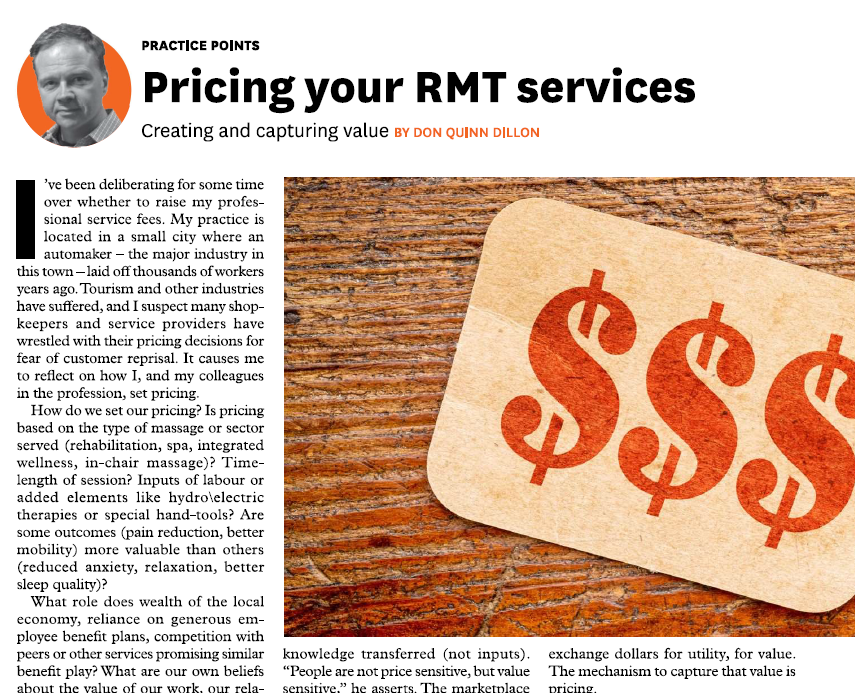
“How do we set our pricing? Time-length of session? Inputs of labour or added elements like hydro\electric therapies or special hand-tools? What are our own beliefs about the value of our work, our relationship and experiences with money, and what we believe patrons are willing to pay? Pricing is how the practitioner “captures” the value they offer to the marketplace. “Price transmits the most important signal to the customer…what the (practitioner) believes the product is worth”, states Ronald J. Baker, author of Pricing on Purpose: Creating and Capturing Value.” – Massage Therapy Canada, Autumn 2016.
Read the article
You may also appreciate What It’s Worth: Reflecting Value in Your MT Care in MTT, page 4
Selling An Established Massage Therapy Practice

“Industrious practitioners from early outset should be preparing for the day when they will pass their turnkey operation over to a new owner, at a lucrative market value. To do so, the practitioner must set up systems to run the practice predictably and automatically, eventually replacing herself with highly competent practitioners and administrators. When the founding practitioner makes herself irreplaceable, it is good for the ego, but bad for the transferable value of the practice.” – Massage Therapy Canada, Summer 2009. Read the article
Also Practical Advice for Practice Retention, MTT Summer 2021, pgs 4-7
Anatomy: Art, Science and Philosophy
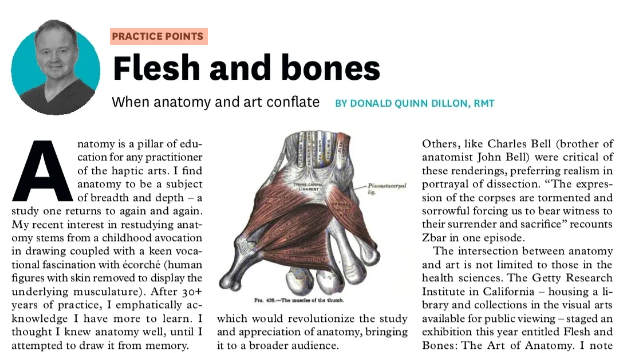
“Anatomists and illustrators have at times shared an impetuous and even fractious alliance. On occasion anatomical art has been deliberately allegorical and even overtly religious, often tinged with a gallows humour or political overtones. The constancy of death was not portrayed in a social vacuum, and it is no coincidence that its more figurative representations emerged just as opera, Shakespearean theatre and ballet were born.”
– Massage Therapy Canada, Autumn 2022. Read the article
Connection Recession
“When the body is not functioning well, it creates great distress for the occupant. It limps, hobbles, buckles. Pain and immobility often present at the outset of injury or disease. Psychiatrist and psychoanalyst Carl G. Jung exclaimed, “While unconscious creation – animals, plants, crystals – function satisfactorily as far as we know, things are constantly going wrong with man.” It appears when things do go wrong, we condemn the body for its frailty. We become anxious at the loss of function, worrying it may be a permanent, pernicious underlying cause. Our body is inseparable in the felt sense of who we are. As the body suffers so does the mind.”
– Massage Therapy Canada, Summer 2020 Read the article
Reclaiming Sensibilities in an Unsensible Time
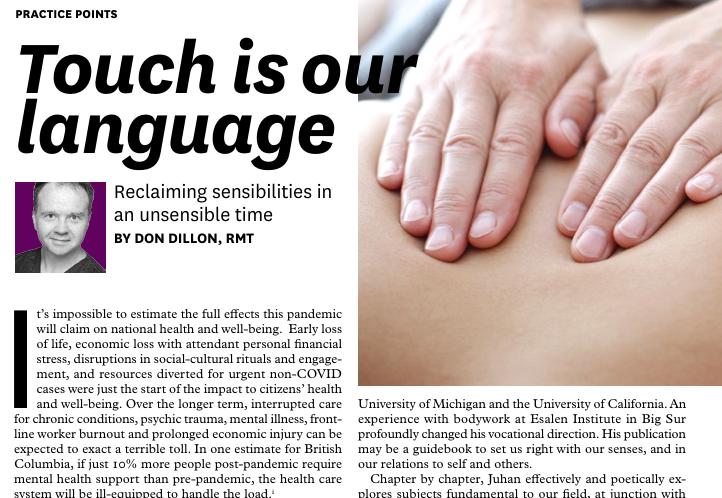
“Deane Juhan argues touch, so important to our development, is a form of language. “…we ignore to our impoverishment whole realms of information, negotiation strategies and adaptive solutions that are the lingua franca of the rest of the animal kingdom.”[i] Promoting “Touch IQ”, Juhan states “bodywork puts us directly in touch with biological intelligence at work in a living creature, and places us in the midst of their processes of learning and adaptive change.”
– Massage Therapy Canada, Spring 2021 Read the article
Also recommended, Participating in the Creation of Ourselves
“Bodywork is one of the most humane and effective means available for generating the streams of full and precise sensory information which compose the largest, most concrete part of self awareness. It is an invaluable tool with which we facilitate the mending not only of our bodies, but those gaps in our objective world view – a world view leading us dangerously far away from our sense of vital participation in our fates.”
Tools, team, technology: Incorporating Variables to Transform Your Practice
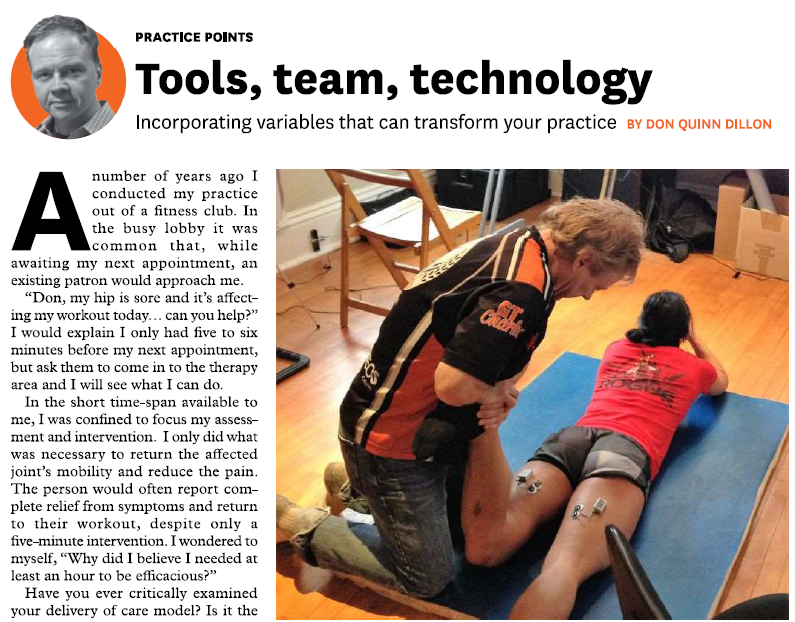
“Have you ever critically examined your delivery of care model? The standard model can be time and labour intensive, and subject the practitioner to strain and fatigue – limiting work capacity and, therefore, income capacity. What if you were to unpack the variables involved in your delivery of care model, and cross-reference with the patient experience and desired practitioner outcomes? – Massage Therapy Canada, Summer 2016. Read the article
Also, Design Longevity into Your RMT Practice in Massage Therapy Today, pages 21-24.
RMT Working Agreements: Let’s Come to Fair Terms

“Practitioners who present to the business with the four “C’s” can fetch better terms, as they provide more value to the business. The more the business has to do for the practitioner, the more the business charges for those services and, subsequently, the less the practitioner gets paid. The more risk the owner takes on, the more assets (capital investment, reputation and location, equipment, customer acquisition and retention costs) the business owner puts forward, the higher the rate she/he can charge for brokering the opportunity for practitioners. These practitioners would otherwise have to put up their own money and time, and invest the resources necessary to develop reputation and location.”
– Massage Therapy Canada, Autumn 2012. Read the article
Also read Contracts Essential to Professional Relations MTT Autumn 2017, pgs 16-17 and Why So Many MT Business Agreements Go Sour MTT Spring 2010, pgs 20-22.
Massage Therapists are Passionate…They Need to Be Political

“Massage therapists have largely avoided advocating their interests in the public sphere. They are passionate advocates for the health and wellbeing of their patients, occasionally calling gatekeeper health disciplines directly in the patient’s interest. RMTs push patients to exercise, sleep enough and get sufficient rest. They demonstrate impressive results and want to be recognized and respected as practitioners in primary health care. So why do they stop short of the ask, “Include us in health care funding, research and provision of services.” Massage therapists are demonstrably passionate…they need to be political.”
– Massage Therapy Canada, Spring 2020.
Read the article
Are You Employable?
“In my discussions with owners/managers from (companies that employ RMTs), I’ve heard criticisms about workplace readiness of many practitioners. Concerns include: 1) practitioners see themselves as individuals, and have trouble integrating into a team practice 2) practitioners demonstrate care for the patient, but are inattentive to the larger patient experience ie: workplace cleanliness, freedom from clutter, first impressions….”
– Massage Therapy Canada, Winter 2015. Read the article
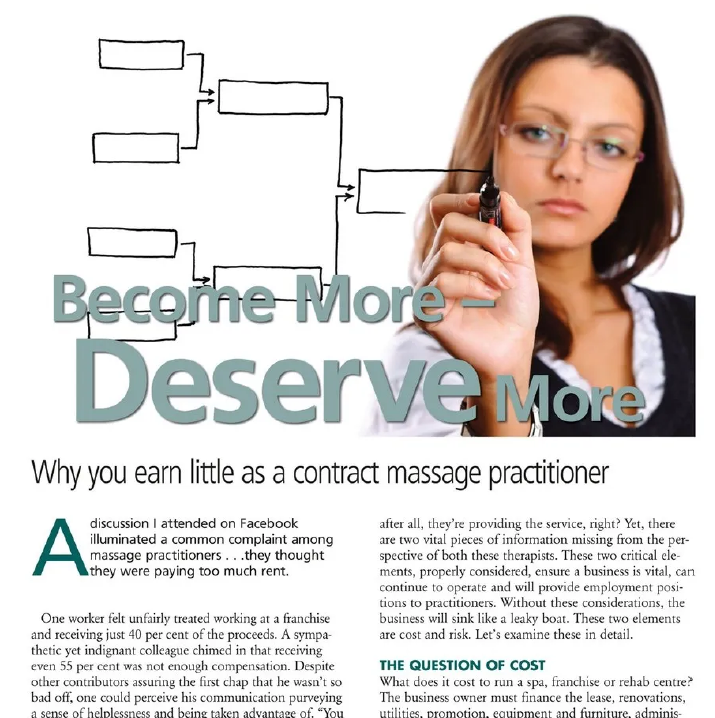
You may also appreciate 21+ Ways to Attract and Retain Business, MTT July 2010, pgs 6-9 and Earn What You Deserve, MTC Spring 2010.
Preventing Brain Drain: Opportunities and Challenges for Higher Education
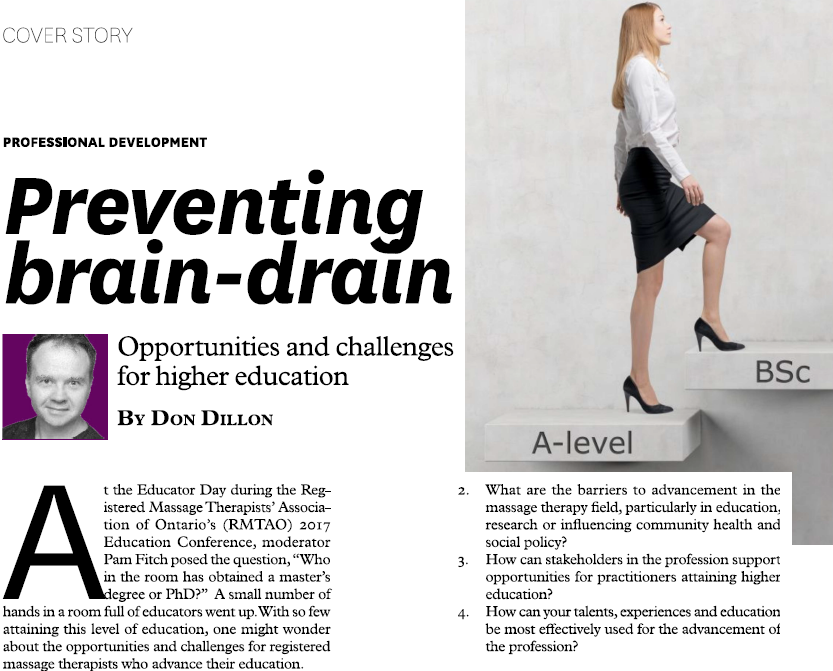
Highly educated RMTs may feel pressure to leave massage therapy in pursuit of research and academic positions in related fields. I invited a group of six RMTs with high academic standing – some educators, others researcher or practitioner status – to address the following questions:
- What opportunities exist for RMTs that pursue higher education?
- What barriers remain to advancement in the MT field, particularly in education, research or influencing community health and social policy?
- How can stakeholders in the profession support opportunities for practitioners attaining higher education?
- How can your talents, experiences and education be most effectively used for the advancement of the profession?
– Massage Therapy Canada, Spring 2018. Read the article
Integrative Medicine: A Model for Better Health Care

“Moderating the panel Role of Massage Therapy in Public Health, Meeker described that Complementary and Alternative Medicine (CAM) professions are all pursuing the same goals: generating research and evidence-based practice, lobbying government for policy change and inclusion in health care, negotiating with the insurance industry for better service funding, and raising the standards of education and training in their respective practitioners. Working alone, each profession is limited by resources and is ultimately slow and ineffective. Meeker suggested CAM professions collaborate on resources, share knowledge and co-ordinate lobbying and education initiatives.”
– Massage Therapy Canada, Winter 2017. Read the article
Also read Physician-Led Integrated Medicine and Research Made Relevant, and also Massage Therapists Are CAM Practitioners First
Critically Thinking
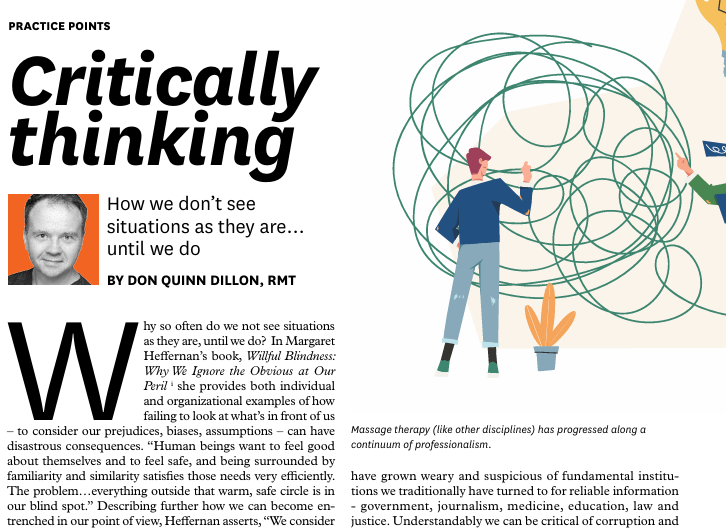
“Our field suffers its share of ideology and conspiracy. Working largely in isolation from each other as we do, with little opportunity to engage with colleagues and dialogue over our observations, compounds the problem. Our field remains flummoxed in working through philosophical differences, and in framing our responses in a considerate, judicious, and informed way. The consequence is that our collective professional credibility is called into question every time one of us demonstrates non-critical thinking. If we’re not regularly engaging our peers – in respectful, diplomatic ways guided by curiosity and mutual regard – we stunt our collective development and consistently fail to broaden and deepen our perspectives and agreements on professional matters. We require critical thinking as a pillar of our thought process.” – Massage Therapy Canada, Autumn 2021 Read the article
Are Massage Therapists Particularly Vulnerable to Allegations?
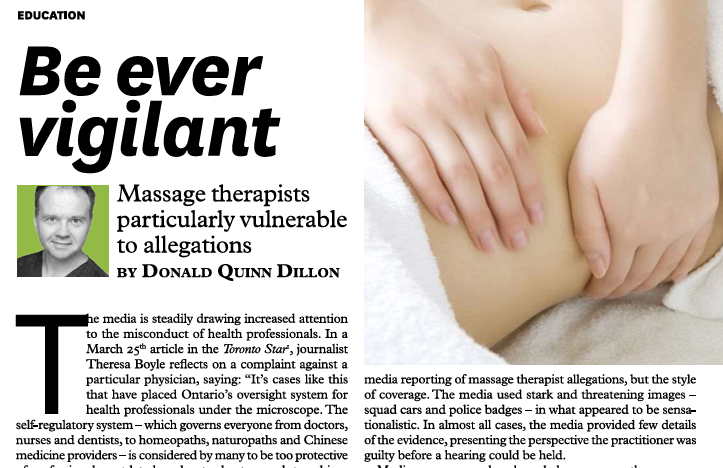
“Massage therapists may be particularly vulnerable to allegations, working as they do with clients of minimal dress and at a high level of touch contact. Unfortunate associations linking the profession to the sex trade, human trafficking and criminal activity still exist, affecting the public trust. This makes interactions for massage therapists with the media and police particularly sensitive.
Are massage therapists increasingly and disproportionately vulnerable to allegations of sexual misconduct? If so, how can they work to prevent allegations or defend themselves if innocent in this delicate and complex media climate? I interview a lawyer and a retired police officer to discover how massage therapists can be better prepared should they face allegations.”
– Massage Therapy Canada, Summer 2018. Read the article
Claims Crisis in Health Insurance: An Opportunity for MTs to Galvanize
“Massage Therapists rely heavily on their patients’ access to employee health benefits, and the implications to massage therapists’ practice of diminishing coverage are severe. MTs cite largely anecdotal evidence of improved patient outcomes and defend their validity in the public eye as regulated health professionals. However, resources to organize experts across the profession to create treatment guidelines backed by available evidence appear unfocused or unavailable.” – Massage Therapy Canada, Autumn 2013. Read the article.
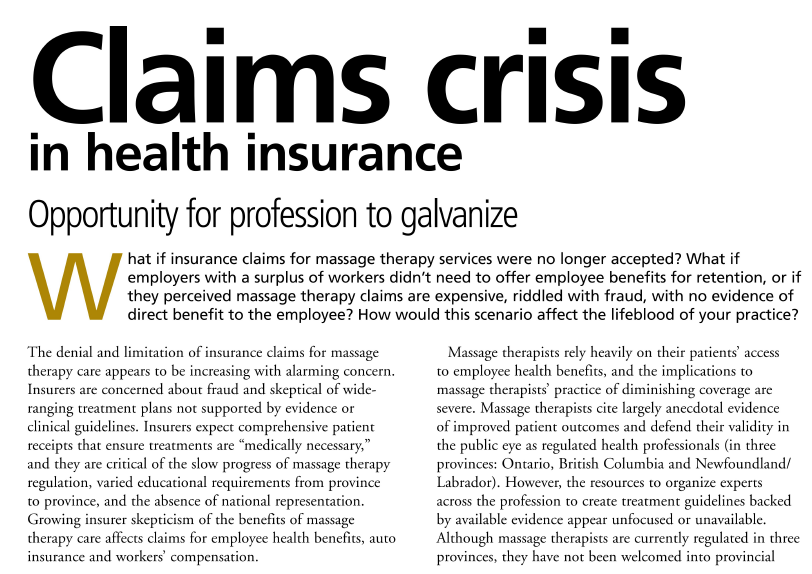
Also, Massage Insurance Fraud, and How to Re-Position RMTs as Positive Contributors to Public Health.
The Link Between Emotions and Physiology
“Medical texts maintain a biological cause of illness, despite extensive research implicating emotions in the causation of many diseases. Autoimmune disorders are a type of civil war, ravaging the body’s own tissues. In one case Gabor Mate, MD shares, “Perhaps her body was doing what her mind could not; throwing off the relentless expectation that had been first imposed on the child, and now self-imposed on the adult…placing others above herself.” – Massage Therapy Canada, Winter 2012 Read the article
In the Pursuit of Wellness, is there a Dark Side?

“While massage therapists espouse the physical, mental and positive psycho-social benefits for a state of well-being, does the pursuit of wellness have a dark side? (Amanda Montell writes) while the wellness ethos promotes positive effects, be careful if you increasingly find your identity and resources tied to serving the brand….Cults (and religions) hold the promise of fulfilling four essential needs: purpose, meaning, community and ritual….as society secularizes and people move from religious practices towards materialism, individualism and consumerism, people inherently pine to fill these essential human needs. Athletic, seemingly self-actualized instructors leading fitness classes, or charismatic television health-promoting gurus can deliver a ‘pastoral experience’ as they usher individuals towards a promised land of problems solved and anxieties vanquished.”
– Massage Therapy Canada, Spring 2022 Read the article
Nurture Your Nomenclature

“As ideas are preserved and communicated by means of words, it necessarily follows that we cannot improve the language of any science without at the same time improving the science itself. Neither can we, on the other hand, improve a science without improving the language or nomenclature which belongs to it.” – Antoine Laurent Lavoisier, Elements of Chemistry.
– Massage Therapy Canada, Winter 2018. Read the article
Take the Spa Industry Seriously
“There’s a divide in our industry where some massage therapists perceive spa massage as ‘not real massage’…pampering without true therapeutic value. The marketplace begs to differ as millions of people clamber to spas ever year to offset stress and tension.”
– Massage Therapy Canada, Autumn 2009. Read the article.
Common Good: National Alliance with Regional Representations Can Offer Best of Both Worlds
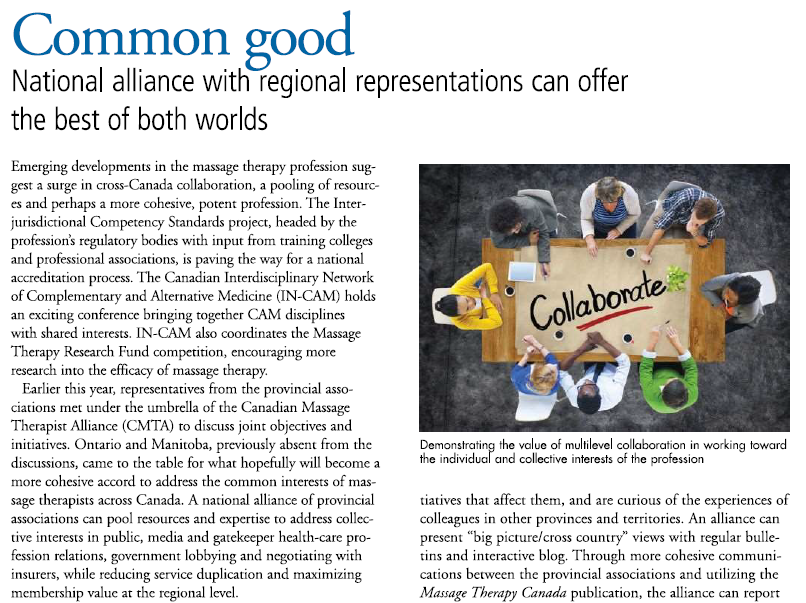
“Massage therapists working in hospitals or long-term care facilities? Positive public/media attention, with massage therapy incorporated into the workplace? Higher educational requirements, stronger research literacy and capacity? Political influence with government, gatekeeper health disciplines and the insurance industry? Are these outcomes possible?
Though these objectives towards the Common Good have remained elusive, emerging developments suggest a surge in cross-Canada collaboration, a pooling of resources and perhaps a more cohesive, potent profession.”
– Massage Therapy Canada, Autumn 2014. Read the article
Boom, Bust, Bane and Breakthrough
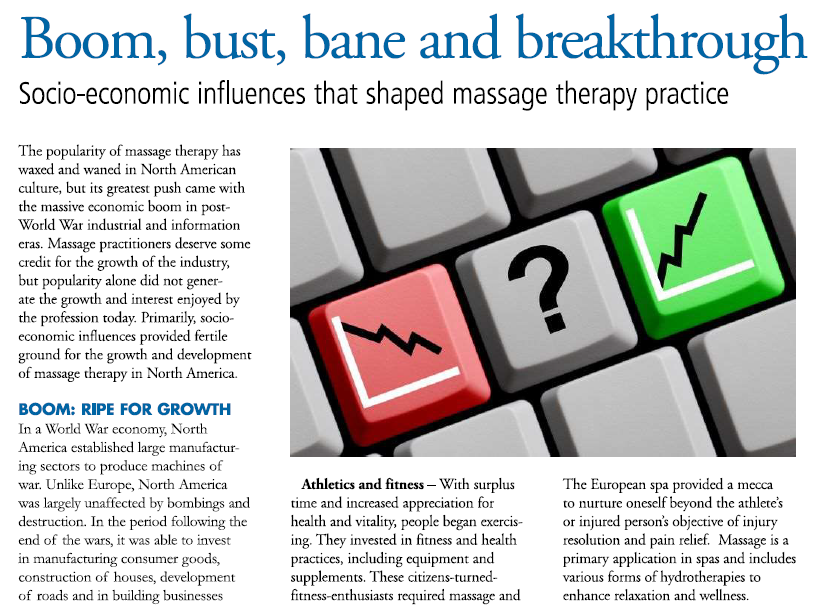
“The popularity of massage therapy has waxed and waned in North American culture, but its greatest push came with the massive economic boom in post-World War industrial and information eras. Massage practitioners merit some credit for the growth of the industry, but popularity alone did not generate the growth and interest enjoyed by the profession today. Primarily socio-economic influences provided fertile ground for the growth and development of massage therapy in North America.
In a World War economy, North America established large manufacturing sectors to produce the machines of war. Unlike Europe, North America was largely unaffected by bombing or destruction, so in the period following the wars were able to invest energy into the manufacture of consumer goods – automobiles, washing machines, houses – as well as creating roads and businesses for people to work. There was a surplus of jobs and a great demand for skilled workers. Employers offered high wages and employee health and dental benefits to retain these workers. Trade unions succeeded in negotiating favourable working conditions to provide workers with more money and leisure time. These economic drivers led to the demand for massage therapy in 5 areas…”
– Massage Therapy Canada, Spring 2015. Read the article

